Description
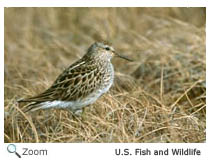 The least sandpiper is the smallest American shorebird. It is
5-6 inches in length with an 11 inch wingspan. It has a pointed black bill with a slight droop at the end; long, yellowish legs; a short neck; and a reddish brown back and wings marked with scalloped-shaped black markings edged in white. It has white undersides, a streaky brown breast, and
a black line on its rump that runs into its tail. It has a thin white line that runs across its upper wings that is visible when it is in flight. In the winter, it is more gray than brown. Males and females look alike. The least sandpiper is the smallest American shorebird. It is
5-6 inches in length with an 11 inch wingspan. It has a pointed black bill with a slight droop at the end; long, yellowish legs; a short neck; and a reddish brown back and wings marked with scalloped-shaped black markings edged in white. It has white undersides, a streaky brown breast, and
a black line on its rump that runs into its tail. It has a thin white line that runs across its upper wings that is visible when it is in flight. In the winter, it is more gray than brown. Males and females look alike.
Range 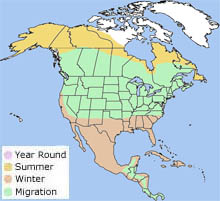 The least sandpiper breeds from
Alaska east to Newfoundland, Canada. It winters
along the Pacific Coast from California south to South America and on the Atlantic Coast from New Jersey south to South America. It is also found in inland areas in the Southeast and the Southwest. The least sandpiper breeds from
Alaska east to Newfoundland, Canada. It winters
along the Pacific Coast from California south to South America and on the Atlantic Coast from New Jersey south to South America. It is also found in inland areas in the Southeast and the Southwest.
. | | |
Habitat
The least sandpiper is found on the tundra during breeding season and on
bogs, marshes with open areas, flooded fields, mudflats, and sandy beaches in the winter.
Diet
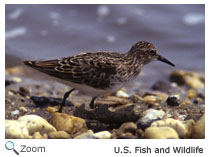 The least sandpiper eats insects,
larvae, small crustaceans, mollusks, marine worms, and some seeds.
They walk with their heads down as they forage for food on the ground. Sometimes, they probe for food in the mud. The least sandpiper eats insects,
larvae, small crustaceans, mollusks, marine worms, and some seeds.
They walk with their heads down as they forage for food on the ground. Sometimes, they probe for food in the mud.
Life Cycle
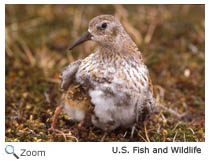 The least sandpiper nests in colonies. The male arrives at the breeding grounds first and establishes a territory. The male and female least sandpiper make a scrape in the ground and line it with leaves, moss, and grass. The female usually lays four eggs. Both parents incubate the eggs for 19-25 days.
The chicks are precocial and leave the nest and feed themselves a day after hatching.
The male and the female care for the chicks, but the female leaves before the chicks fledge at three weeks old. The least sandpiper nests in colonies. The male arrives at the breeding grounds first and establishes a territory. The male and female least sandpiper make a scrape in the ground and line it with leaves, moss, and grass. The female usually lays four eggs. Both parents incubate the eggs for 19-25 days.
The chicks are precocial and leave the nest and feed themselves a day after hatching.
The male and the female care for the chicks, but the female leaves before the chicks fledge at three weeks old.
Behavior The least sandpiper is a relatively solitary bird and usually
usually roosts by itself or in small groups.
|

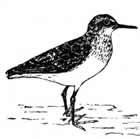

 The least sandpiper breeds from
Alaska east to Newfoundland, Canada. It winters
along the Pacific Coast from California south to South America and on the Atlantic Coast from New Jersey south to South America. It is also found in inland areas in the Southeast and the Southwest.
The least sandpiper breeds from
Alaska east to Newfoundland, Canada. It winters
along the Pacific Coast from California south to South America and on the Atlantic Coast from New Jersey south to South America. It is also found in inland areas in the Southeast and the Southwest. 
